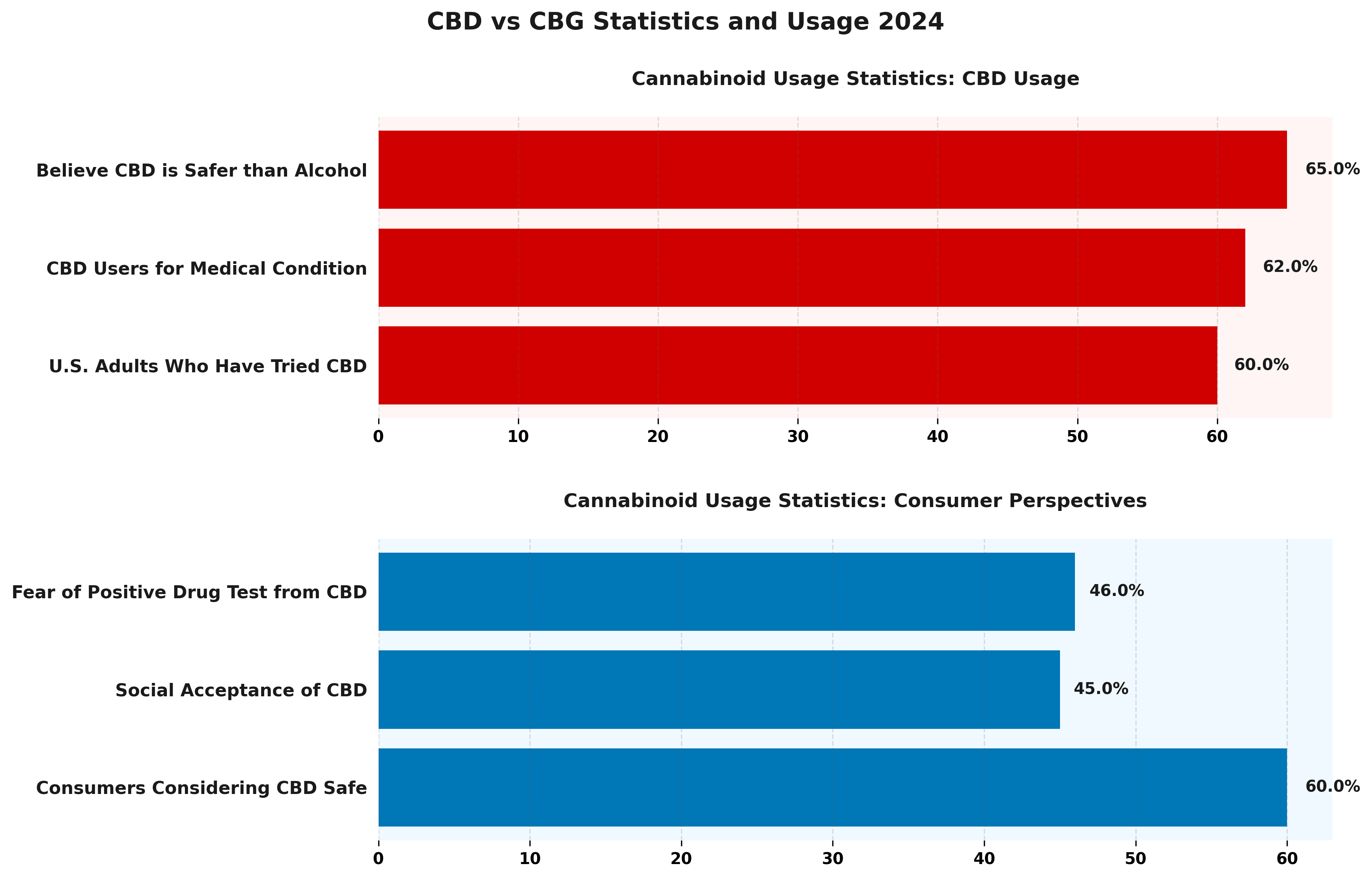
As the field of cannabinoids continues to evolve, cannabigerol (CBG) and cannabidiol (CBD) are increasingly recognized for their potential therapeutic benefits. While both compounds originate from the cannabis plant, they exhibit significant differences in their chemical structures, effects on the human body, and medical applications.
This article examines these distinctions, explores their respective medical uses, and addresses potential side effects, legal considerations, and guidance for selecting the most appropriate option based on individual needs.
Key Takeaways:
- CBG and CBD are both cannabinoids derived from the cannabis plant, but they have different chemical structures and effects on the body.
- Both CBG and CBD have potential medical uses, but research is still ongoing and their effectiveness may vary for different conditions.
- Possible side effects of CBG and CBD include gastrointestinal issues and interactions with other medications, so it is important to consult with a healthcare professional before use.
What are CBG and CBD?
CBG (Cannabigerol) and CBD (Cannabidiol) are two prominent cannabinoids extracted from the Cannabis sativa plant, each exhibiting distinct properties and therapeutic applications that can provide a wide range of health benefits. Although both compounds interact with the endocannabinoid system, they differ in their chemical structures, mechanisms of action, and physiological effects, rendering them significant subjects for scientific investigation. A comprehensive understanding of the distinctions and similarities between CBG and CBD is essential for consumers seeking to leverage the therapeutic potential of these compounds.
CBG is often referred to as the “mother of cannabinoids,” as it serves as a precursor to other major cannabinoids, including CBD and THC. Emerging studies underscore its potential neuroprotective properties and its capacity to reduce inflammation, which may benefit conditions such as inflammatory bowel disease.
Conversely, CBD has been more extensively studied, with research demonstrating its effectiveness in alleviating anxiety and promoting sleep. Both CBG and CBD interact with cannabinoid receptors in the brain and immune system, helping with the regulation of various physiological functions.
Recent statistics indicate that over 60% of users report positive effects from CBD, while the therapeutic potential of lesser-known minor cannabinoids, such as CBC and CBN, is also gaining recognition in scientific research. This suggests a promising landscape for future investigations into their combined health benefits.
CBD vs CBG Statistics and Usage 2024

The CBD vs CBG Statistics and Usage 2024 provides insights into the prevalence and perceptions of CBD usage among U.S. adults, highlighting its medicinal appeal and societal viewpoints. With an increasing number of individuals exploring cannabinoid-based products, understanding these trends is crucial for stakeholders in the wellness and healthcare sectors.
Cannabinoid Usage Statistics reveal that 60% of U.S. adults have tried CBD, indicating widespread interest in its potential benefits. The data shows that 62% of CBD users utilize it for medical conditions, underscoring its significant role in alternative medicine. This trend reflects growing trust in CBD’s therapeutic properties, particularly for managing pain, anxiety, and sleep disorders.
- Perceptions of Safety: A notable 65% of consumers believe CBD is safer than alcohol, suggesting a shift in public opinion favoring natural and plant-based remedies over traditional intoxicants. This perception is bolstered by 60% of users considering CBD safe, reflecting confidence in its non-psychoactive nature and minimal side effects.
Consumer Perspectives illustrate mixed views on CBD’s social acceptance and potential drawbacks. While 45% recognize its social acceptance, indicating a gradual normalization, a significant portion of the population remains cautious. Concerns persist among 46% of consumers about testing positive on drug tests due to CBD use, highlighting the need for clear labeling and consumer education regarding THC content in CBD products.
The data underscores a growing acceptance and utilization of CBD, driven by its perceived safety and medicinal benefits. However, lingering societal and regulatory challenges highlight the importance of further research and public education to address misconceptions and enhance acceptance of CBD in broader contexts.
Chemical Differences Between CBG and CBD
The chemical differences between CBG and CBD are substantial, as these cannabinoids possess distinct molecular structures that affect their respective effects and interactions within the human body.
CBG, commonly known as the “mother cannabinoid,” acts as a precursor to other cannabinoids, including CBD and THC, thereby creating a unique pathway for therapeutic benefits. This chemical variation is crucial for comprehending how these cannabinoids may influence a range of conditions, from anxiety disorders to skin health.
Structural Differences
CBG and CBD exhibit significant structural differences, with CBG classified as a biphenolic compound characterized by a unique arrangement of carbon, hydrogen, and oxygen atoms. This structural distinction is essential as it influences how each cannabinoid interacts with the body’s cannabinoid receptors, leading to varied physiological responses.
The atomic arrangement in CBG allows for more effective binding with specific receptors, which may result in different therapeutic benefits compared to CBD. For example, CBG’s distinctive configuration may enhance its capacity to modulate pain and inflammation, positioning it as a promising candidate for certain medical applications.
In contrast, the phenolic structure of CBD plays a crucial role in its well-documented anti-anxiety and neuroprotective properties.
Research indicates that CBG may also contribute to neurogenesis, while numerous studies link CBD to the alleviation of anxiety disorders. These distinct interactions highlight the significance of the chemical structures of cannabinoids in therapeutic contexts, informing their development for clinical use.
Effects on the Body
The effects of cannabigerol (CBG) and cannabidiol (CBD) on the human body underscore their therapeutic potential, as both cannabinoids demonstrate a variety of beneficial properties that can influence bodily functions and maintain homeostasis through interactions with the endocannabinoid system.
While CBD is widely acknowledged for its anti-inflammatory and anxiety-reducing effects, CBG is gaining recognition as a promising candidate for addressing conditions such as neurodegeneration and bladder dysfunction.
Recent clinical studies have indicated that CBD can significantly reduce seizure frequency in patients with epilepsy, thereby showcasing its neuroprotective capabilities. In parallel, CBG has shown potential in inhibiting tumor growth in various cancer models.
Both cannabinoids appear to offer pain relief through their interactions with the endocannabinoid system, presenting new opportunities for pain management that avoid the side effects typically associated with opioid use.
The anti-inflammatory properties of both compounds suggest their potential utility in the treatment of inflammatory bowel diseases, such as ulcerative colitis. Additionally, emerging research indicates that these cannabinoids may effectively manage various skin disorders by promoting healthier inflammatory responses.
Medical Uses of CBG and CBD
CBG and CBD are gaining recognition for their medical applications, supported by an expanding body of scientific research that underscores their therapeutic uses across a range of health conditions.
These cannabinoids are being investigated for their potential to alleviate symptoms associated with anxiety disorders, enhance skin health, and address more serious ailments such as glaucoma and colon cancer.
As clinical studies continue to develop, the medical community is acquiring a more comprehensive understanding of how CBG and CBD may serve as complementary therapies to traditional treatments.
Conditions Treated
CBG and CBD have demonstrated potential in addressing a range of medical conditions, including anxiety disorders, skin disorders, and inflammatory conditions, thereby serving as valuable components in functional medicine approaches. The therapeutic benefits of these cannabinoids can significantly enhance treatment outcomes for patients suffering from conditions such as Huntington’s disease, inflammatory bowel disease (IBD), and certain types of cancer.
Both cannabinoids have attracted considerable attention within scientific communities for their neuroprotective properties, particularly in the context of Huntington’s disease, where they may contribute to slowing the progression of symptoms. In the case of inflammatory bowel disease (IBD), CBG has shown the capability to reduce inflammation and improve gut health through its interaction with endocannabinoid receptors.
Conversely, the efficacy of CBD in managing chronic pain and anxiety is well-established, with research indicating that it may modulate serotonin levels, thus providing relief for individuals with mental health disorders.
While the side effects are generally minimal, including fatigue or changes in appetite, it is essential to approach these treatments under the supervision of a healthcare provider. This ensures a holistic and safe integration of these cannabinoids into comprehensive wellness plans.
Efficacy and Research
The efficacy of cannabigerol (CBG) and cannabidiol (CBD) is increasingly supported by a substantial body of scientific research and clinical studies that underscore their therapeutic applications across various health contexts. Preliminary findings indicate that CBG may exhibit antibacterial properties, while CBD is well-established for its neuroprotective and anti-inflammatory effects.
Research has progressively concentrated on the specific health benefits associated with these cannabinoids, particularly in the management of chronic pain, anxiety, and epilepsy. For example, recent clinical studies have shown that CBG may alleviate symptoms of inflammatory bowel disease and could enhance appetite, suggesting its potential for further investigation in conditions such as cancer and anorexia.
In contrast, CBD has garnered considerable attention for its capacity to reduce seizure frequency in certain forms of epilepsy, especially in cases that are resistant to treatment. Additionally, it shows promise in improving sleep quality and alleviating anxiety, indicating a critical need for further exploration into safe dosages and long-term effects of these compounds.
Side Effects of CBG and CBD
Although CBG and CBD are typically well-tolerated, it is essential for users seeking therapeutic benefits to understand the potential side effects and possible adverse reactions.
Some individuals may experience mild side effects, including fatigue, nausea, or changes in appetite. These effects can vary based on the dosage and the individual’s sensitivity to cannabinoids.
Possible Adverse Reactions
Possible adverse reactions to CBG and CBD may occur, particularly when these compounds are used in conjunction with other medications or at elevated doses. Commonly reported side effects include dry mouth, fatigue, and alterations in mood or appetite, which can be influenced by individual body chemistry as well as the presence of other cannabinoids, such as THC.
Individual reactions can vary significantly due to factors such as dosage, personal tolerance levels, and pre-existing health conditions. Research indicates that while these compounds are generally well-tolerated, there are instances where users may experience increased anxiety or gastrointestinal discomfort, particularly at higher dosages.
Several studies, including those published in the Journal of Clinical Psychology, have raised concerns regarding potential interactions with other medications, underscoring the importance of consulting healthcare professionals prior to initiating any new supplements. This is particularly critical for individuals already taking prescription medications, as CBG and CBD may affect the metabolism of certain drugs, potentially leading to unforeseen adverse effects.
Legality of CBG and CBD
The legality of CBG (cannabigerol) and CBD (cannabidiol) is a complex issue that varies significantly across different jurisdictions. It is imperative for both consumers and medical professionals to remain informed about the current legal status and regulations pertaining to these cannabinoids.
Following the passage of the 2018 Farm Bill, hemp-derived CBD has gained broader acceptance; however, CBG is also receiving increased recognition, albeit with potential regulatory challenges in certain regions.
Current Legal Status
The current legal status of CBG and CBD is undergoing significant evolution, with numerous countries adopting regulations that permit the use of hemp-derived cannabinoids while imposing restrictions on THC levels. As public interest in these substances increases and research continues to underscore their potential benefits, jurisdictions are beginning to modify their laws to enhance access to CBG and CBD products.
For example, the European Union has established regulations that permit the extraction of CBD from legally cultivated hemp; however, individual member states impose their own restrictions, resulting in a fragmented legal landscape. In the United States, the Farm Bill of 2018 legalized hemp-derived CBD at the federal level, yet several states have chosen to implement their own more stringent guidelines.
Regulatory bodies such as the U.S. Food and Drug Administration (FDA) and the European Food Safety Authority (EFSA) play critical roles in determining safety and quality standards, directly influencing the marketing and consumption of CBG and CBD products.
These regulations ultimately impact consumer rights and access to various cannabinoid options, as ongoing legal developments strive to balance health benefits with public safety concerns.
Regulations and Restrictions
Regulations and restrictions concerning CBG and CBD are critical for both consumers and businesses operating within the cannabinoid market, as these laws govern the manufacturing, sale, and distribution of these compounds. Ensuring compliance with local regulations is imperative to avoid legal complications and to guarantee product safety.
Various regulatory agencies, including the FDA and state-level departments, significantly influence product labeling, potency specifications, and overall consumer protection in the cannabinoid industry. For example, these agencies mandate clear labeling that accurately reflects ingredients and cannabinoid concentrations to prevent misleading claims.
This requirement not only enables consumers to make informed purchasing decisions but also fosters a degree of standardization across products, ensuring that they meet essential safety and quality benchmarks.
Ongoing evaluations by these regulatory bodies can result in changes to guidelines, necessitating that businesses remain informed and adaptable in an evolving market landscape.
Choosing Between CBG and CBD
The decision to choose between CBG and CBD necessitates careful consideration of several factors, including the distinct health benefits associated with each cannabinoid, personal preferences related to treatment methods, and individual health conditions.
It is imperative for consumers to comprehend the unique characteristics of both cannabinoids in order to make informed choices that align with their wellness objectives.
Factors to Consider
When selecting between CBG and CBD, it is essential to consider several factors, including the specific health benefits associated with each cannabinoid, the preferred mode of consumption, dosage requirements, and individual responses to cannabinoids. These considerations will guide consumers toward the option that best aligns with their unique health needs.
Both CBG and CBD provide distinct therapeutic effects. For example, CBG has demonstrated potential in promoting appetite, making it an appropriate choice for individuals facing eating disorders or undergoing treatments that suppress hunger. Conversely, CBD is widely acknowledged for its potential anxiety-reducing properties, which may benefit those experiencing stress or chronic anxiety.
Side effects may differ based on the cannabinoid and the individual’s specific biochemistry; for instance, CBG may induce mild drowsiness in some users, while others may experience a stimulating effect. Ultimately, personal preferences concerning taste, method of delivery—such as oils, capsules, or edibles—and specific health objectives will play a significant role in the decision-making process.
Personal Preferences and Needs
Personal preferences and needs significantly influence the choice between CBG and CBD, as individuals may prioritize various effects, extraction methods, or product formulations according to their specific health objectives. A thorough understanding of these preferences can assist consumers in identifying the most appropriate cannabinoid for their particular circumstances.
For example, an individual seeking relief from anxiety may favor CBD, which is widely recognized for its calming properties, while another person experiencing inflammation might find CBG to be more advantageous due to its potential anti-inflammatory effects.
User testimonials frequently highlight how these subtle differences have impacted their selections; one user noted, “I initially tried CBD for stress but found CBG to be a game-changer for my chronic pain.”
Such insights emphasize that the decision-making process encompasses not only the compounds themselves but also the alignment of these compounds with personal health journeys and desired outcomes.
